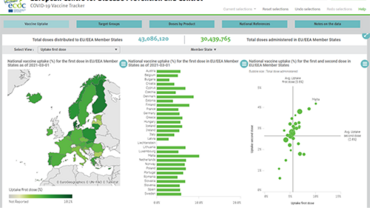Rollout of COVID-19 vaccines in the EU/EEA: challenges and good practice
The aim of this report is to share the challenges countries are facing with the rollout of the COVID-19 vaccine deployment process. It also aims to share lessons learned and good practice that countries have put in place to mitigate the challenges.
Executive summary
Key findings
This document outlines the key challenges that countries are facing with the COVID-19 vaccination rollout and lessons learned to mitigate these challenges.
-
The majority of responding countries (26/28, 96%) reported challenges related to the limited supply of COVID-19 vaccines, as well as frequent changes in timing of deliveries from vaccine producers, which can be unpredictable and can significantly affect the planning and efficiency of the rollout.
-
The logistics to rollout vaccines with different characteristics around storage, transport and administration (e.g. timing of the second dose, indicated age groups, contraindications) is complex and half of the countries (n=12) reported challenges with effective strategies to limit discarding of unused vaccines (e.g. open vial wastage). Some countries avoid the wastage of vaccines by administering remaining doses to healthcare workers at the end of each vaccination session, or set up reserve lists of people willing to be vaccinated.
-
Staffing shortages to administer vaccines was a challenge reported by six countries. Hiring and training more medical and even non-medical staff seems essential to progress in the mass vaccination campaign.
-
Ten countries (36%) reported challenges around a shortage of equipment needed for vaccination, specifically with a lack of dead-space syringes and needles to extract more doses from vaccine vials. Stockpiling, when necessary equipment is available, and central distribution may help to overcome these challenges.
-
Seven countries (25%) reported challenges around reaching certain populations, especially those individuals who have difficulties leaving their homes. Some countries try to address this challenge by running vaccination centres with multidisciplinary teams and by vaccinating immobile patients at home by their general practitioners.
-
Six countries (21%) reported communication challenges related to misinformation and disinformation around COVID-19 vaccines, which may affect vaccine acceptance. Countries also reported challenges with communicating about prioritising certain groups and the rationale behind this; and communicating about the efficacy and safety of different vaccine products and decisions taken regarding the protocols for their administration at national level. The extent and issues of vaccine acceptance and hesitancy vary across countries with specific local social and cultural patterns.
-
Setting up systems for scheduling individual vaccination appointments and ensuring that the most effective system used to contact the different priority groups is a challenge for 10 countries (37%). While countries mostly try to have a digital system in place to first register and then secure a timeslot for vaccination, it is important to keep alternative systems to reach specific subgroups, such as the elderly, including paper-based registries and phone call options rather than relying solely on online registration.
-
All reporting countries have either an immunisation information system or an electronic immunisation registry in place, or are currently implementing an ad-hoc system to record individual vaccination status. However, challenges regarding IT issues, data quality and data completeness have been mentioned. It was suggested that functioning systems for reporting suspected adverse events following immunisation are needed, and a proposal to have a plan in place to communicate about any adverse events that may occur.
The COVID-19 vaccine rollout is a dynamic process and this report provides a snapshot of the challenges countries are facing at this time.
Download

Errata: 31 March 2021. In the final paragraph of the Conclusions, the text was revised to more accurately reflect the current situation, and a footnote was added on page 11.







